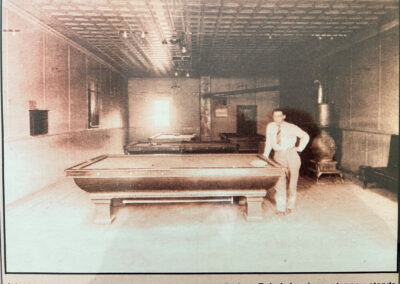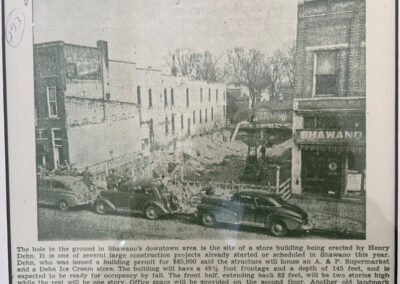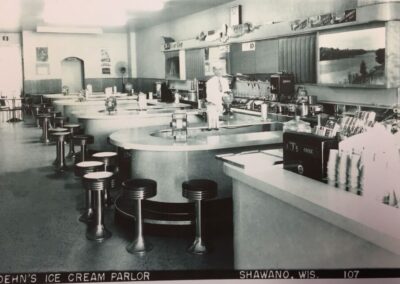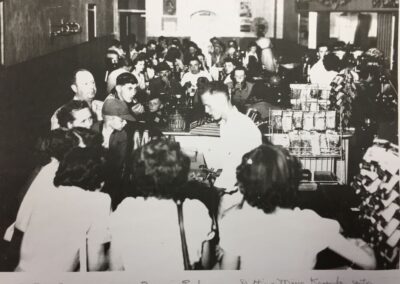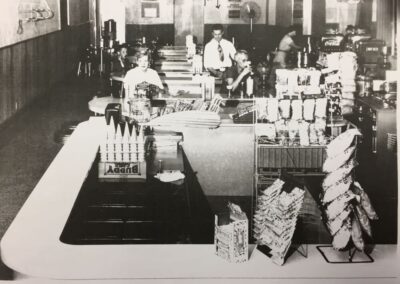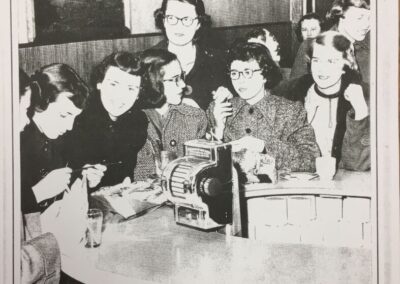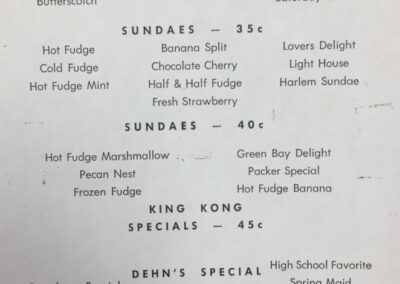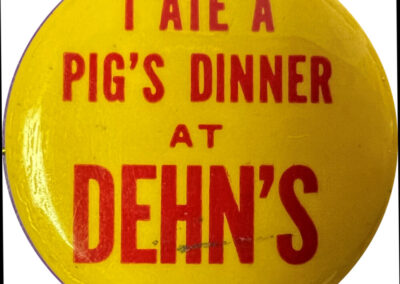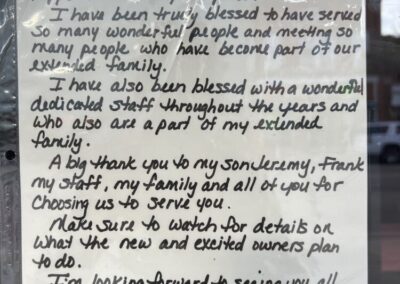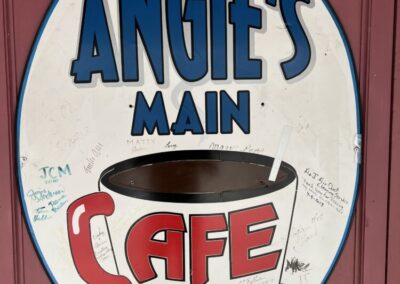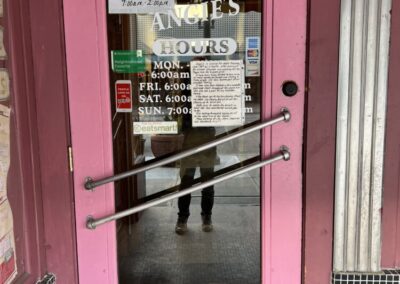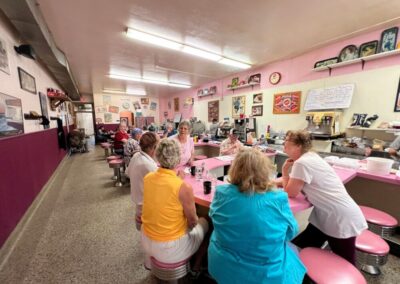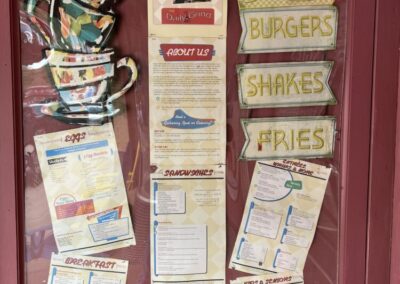Location
Photo Gallery
A Brief History
Dehn’s Ice Cream Parlor
132 South Main Street
Shawano, Wisconsin
Henry Dehn purchased the former John Keohane building in the late 1930s. Henry used this store to retail some of his ice cream products produced at his Bonduel factory. This building had previously been used as a pool hall operated by John Keohane and later as a diner that served sandwiches and fruit. It was located on the north half of the current building. Tragedy struck this store in the form of a fire and for a number of years, Shawano did not have a Dehn’s Ice Cream Parlor.
In 1948, the former Dehn’s Ice Cream store and Peterson Variety Store were razed, and an A & P Supermarket and a new Dehn’s Ice Cream Parlor emerged. This time, the new ice cream parlor was located on the south half of the current building. It measured 49.5 feet in front and had a depth of 145 feet. The frontage part of this building was two stories and measured 82 feet. The rest of the building was one story.
Henry then asked a former employee, Marvin Kroenke to manage the business for him. Marvin had previously worked at his ice cream factory from 1938 to 1940 before he entered the military service in WWII.
The Kroenkes added sandwiches, hamburgers and chili to their menu in 1952. After seeing the success of offering these additional food items at the Shawano store, Henry Dehn also added these items to the stores in Green Bay and DePere. A lady’s dress shop and other offices were located up-stairs. The Kroenkes managed the ice cream parlor from 1948 to 1981, making it a landmark name in Shawano.
The building’s unique interior had built-in, diner-style seating and a cooking area with an undulating bar and stools seating. It also had “individual stations” in bar seating area that accessed juke box music. It was a very popular business bustling with activity in the 1950’s, 60’s, and 70’s. Teen-agers especially frequented the diner and ice cream parlor.
Marvin and Dottie Kroenke managed this store for Dehn’s Incorporated, which at different times was owned by Henry Dehn, Harvey Heck, Silvian Tessier, and Francis Ourado. Francis, the remaining partner, sold the real estate to Hilgenberg Realtors in 1981 and in turn, Hilgenberg leased the building to Orv and Judy Westphal. The furnishings, equipment and franchise to sell Dehn’s Ice Cream was again, secured through Dehn’s Inc. At this point, the business was known as Orv and Judy’s Joint. Dehn’s inc. dissolved as a corporation in 1992.
Orv and Judy Westpahl operated the ice cream parlor until 1983 when they sold the business to Willard Kriefall. Kriefall operated the business until Hilgenberg Realtors sold the real estate to Marvin and Judy Popp in 1992. Marvin and Judy operated the business under the name of Popp’s Diner for six years. While the Popp’s owned the business, they created an opening between the two properties to provide more dining and restaurant facilities for family dining and banquet opportunities for large groups. The business still maintains a 1950s era counter setting as well as a more formal dining area.
In October of 1998, Marvin and Judy Popp sold the entire facility and business under a land contract to Coffee and Café Company, LLC, owned by Angie Bistoff. On July 10, 2001, the land contract was satisfied and ownership was transferred by Warranty Deed to Coffee and Café Company, LLC. Angie renamed and continued to operate the business under the name of Angie’s Main Café and Daily Grind until 2022 when she retired. Angie then sold the building to Suzette Hackl in 2022. Ms. Hackl opened Thornberry Cottage Boutique and The Gourmet Cafe in the completely remodeled building.
From the 1999 National Register of Historic Places Registration application:
One of the district’s newer historic commercial buildings, this building is also one of the most intact. Although both sides were historically operated by the same dairy goods company, this building’s dual use is evident in the design of its storefront, which is original to the building. The northern and larger portion of the storefront area, which historically housed a retail store, has plate glass display windows set flush with the brick corner piers. The plates are framed with narrow aluminum strips and set on a black tile bulkhead. Near the entry, slightly south of the building’s center, the northern storefront’s display window turns away from the street at a nearly perpendicular angle and extends inward to the plane of the door. Between the interior comer of this display window and the deeply inset double doorway is a narrower display window with the same general features. This window is bordered on the edge adjoining the door by a wide aluminum pilaster with Streamlined-style vertical flutes or “speed lines.” This feature extends past the upper framing of the window to die ceiling of this inset entry way, a few inches above the windows. Over the double doors and aligned with these windows is a wide, plain transom light in a wood frame below an aluminum horizontal framing member that extends across the doorway area. The double doors beneath this transom are each simple wood frame with a large plate glass window and two round aluminum push bars set at a thirty degree angle; these appear to be original. Adjoining the southern edge of the south door is a wide aluminum pilaster identical to that described previously. The display window for the historic restaurant portion of the building to the south commences perpendicular to this pilaster and extends approximately three feet toward the street. At that point it is joined by narrow aluminum band identical to those described previously. The adjoining display window follows a ninety-degree arc and adjoins a single, flat plate glass window that adjoins a door leading to the second floor. The door opens against the building’s southern brick wall; it and the restaurant’s display windows are inset approximately four feet from the larger display window to the north and from the rest of the facade of the building. The upper facade has seven windows and no ornamentation with the exception of a plain, narrow concrete band that encircles all seven windows across the facade. The upper windows have no distinguishing characteristics but appear to be original. As a result, this building may be seen to have exceptional overall integrity. It should also be noted that the interior of the historic restaurant portion of the building has an intact, built-in, diner-style seating and a cooking area with an undulating bar and stools that is either original to the building or dates from within a few years of its construction. Such interiors are uncommon in the Shawano region.

